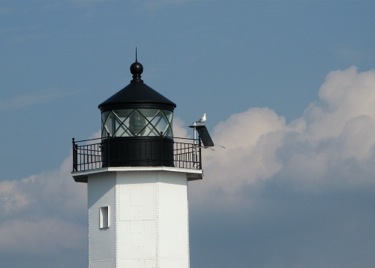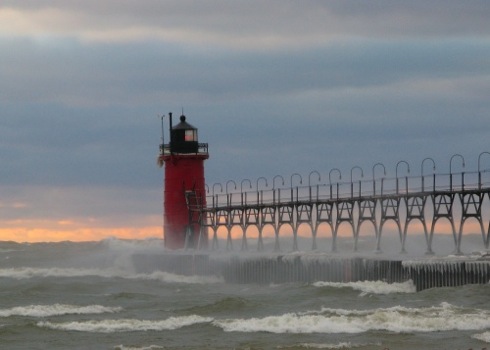Lighting The Lake: South Haven's Civil War Lighthouse Keeper James Donahue

Lighthouses have been used to help guide sailors for thousands of years. The ancient Egyptians were the first to actually build lighthouses; prior to this, fires were lit along hilltops as a warning to mariners. One of the classical Seven Wonders of the World was the 400 foot tall Pharos lighthouse of Alexandria which was destroyed by an earthquake in the 3rd century B.C. Here in America, the Mayans used lighthouses such as Tulum in Mexico to guide sailors through the Caribbean, while the first North American lighthouse was Boston Light, built in 1715.
In Michigan, over 115 lighthouses have served as beacons for the sailors of the Great Lakes. Each issue of Lake Effect Living will focus on one of these impressive structures. This autumn, Michigan author and lighthouse historian Meg Mims focuses on South Haven's most celebrated lighthouse keeper, Civil War veteran James Donahue.

South Haven’s South Pier Lighthouse:
Civil War Veteran Lighthouse Keeper James Donahue
Imagine a 30-foot tall wood structure on the South Haven pier, supported by pillars and open to the crashing waves of Lake Michigan. Imagine this lighthouse, along with its connecting 75-foot long wooden walkway that stretched shore-ward to the keeper’s dwelling on the bluff, coated in ice ribbons. Imagine a man on crutches crossing that walkway every day for 36 years, regardless of heat, rain, snow or ice. A picture of true dedication, indeed.
James S. Donahue, born in Vermont, rose to the rank of Captain after being wounded serving in the Eighth Michigan Infantry during the War Between the States. He lost a leg at the thigh in the Battle of Wilderness and resigned from the Army. Donahue was hired in April of 1874 at 32 years old to be South Haven’s second lighthouse keeper. The job entailed lighting the cast iron lantern each night, keeping meticulous records of weather, visitors, events or problems encountered, maintaining the keeper’s residence, the lighthouse and supplies, plus any necessary repairs. From simple paint jobs to saving sailors’ lives from ships stranded near the lakeshore, a lighthouse keeper had to be an incredibly capable hard worker. James Donahue “never missed a day on the job, even if he had to crawl out the pier to do it.”
The keeper’s logbook entry, dated July 3, 1875, is haunting: “Rain and cloudy, wind moderate, lake smooth, the night dark, the weather warm – my wife died this afternoon at 4 pm, of lung disease.” The next day’s entry read: “Foggy, wind, the fog thick all day, the lake smooth, the night dark – I berryed my wife to day at 4 pm.” Since Donahue had a young son by his first wife, he married again within the year. James and Ann Kyme Donahue welcomed five more sons and a daughter by 1893. A family photograph showed the keeper in his uniform surrounded by his sober wife and children. Another photo shows his extended family and a dog on the lawn beside the trim, neat keeper’s residence.
In heavy weather, the keeper or his family had to stay the night in the tower and keep watch for any ships needing help. From the log book dated May 5, 1881: “I went to the village councal one hour in the evening. My wife and brother was at the end of the pier blowing the foghorn and braut in the Steam Tug Mirands at eight thurty PM.” At the time, the foghorn operated by hand using a bellows. Given a long fog-bound night, confined to a small space, perhaps chilly even in midsummer or half-frozen in winter, two people taking turns kept vigil despite the waves and weather to prevent tragedy.
The entire family helped with daily chores. Donahue also ran a boat rental to supplement his income. Taking in a boarder or two also helped many families make ends meet. More remote lighthouse stations rarely had visitors or opportunities for interaction, either for extra income or social contact. Donahue was no doubt thankful to be stationed in South Haven which was close to a thriving port. A lively man who was popular with local residents, Donahue even sold real estate in the area. Photographs from the era show him with his trust-worthy crutches.
Kerosene was the usual type of fuel used in lighthouse lanterns. In 1890, however, South Haven was fitted with a Walsbach burner light which used gasoline. Around this time, gas stoves for cooking and heating became popular. The Walsbach burner doubled the light’s intensity and cut fuel requirements in half. More improvements occurred in 1900 when South Haven’s pier was extended another 400 feet from the shore. The tower was moved to the end of the pier in 1901, and a new section built to join with the old catwalk. The following year, the Light House Board ordered a Fifth Order Fresnel lens installed into the deteriorating wooden tower and hired 11th District Engineer James G. Warren to replace it with a metal structure.
A crew arrived with a prefabricated tower 35 feet tall and spent a month erecting the new tower, and painting it white. A cupola that served 40 years in the Muskegon lighthouse was set on top, and the Fresnel lens was carefully removed from the old tower to the new lantern room. “Captain Donahue proudly climbed the spiral stairs within the new tower to exhibit the South Haven light… for the first time on the evening of November 13, 1903.”
Donahue retired in 1910 after saving 17 lives. He often jumped into the water to save them, including two of his own sons, and earned a silver medal in recognition of his heroic acts. Local residents of South Haven may have considered silver second-rate, since they fashioned their own medal of gold and awarded it to him. James Donahue died in 1917, was buried with honors at the Lakeview Cemetery and unknowingly served as a model for the fictional one-legged lighthouse keeper Trevor Tavish in “Ghostly Lights” written by Annick Hivert-Carthew.
The keeper’s dwelling is currently one of the Michigan Maritime Museum's complex of buildings. South Haven’s South Pier light still stands and is open to the public during the annual June Harborfest, free of charge.
---Meg Mims, © Sept. 2010
Lighthouses of Southwest Michigan, Susan Roark Hoyt, Arcadia Publishing, 2003
Sights and Scenes along the Michigan Central Line: Marshall, Michigan, University of Michigan Library, 1895
See South Haven Pier Light at Seeing the Light: Lighthouses of the western Great Lakes
See the Lighthouse Explorer database at Lighthouse Depot
West Michigan Tourist Association page on the South Haven Pier Light
October/November 2010